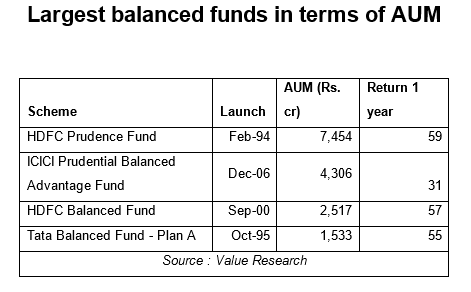Assets under management in the category have increased 64% in April-November 2014.
Balanced funds, which invest in a mix of debt and equity, are getting increasingly popular among investors.
The assets under management in balanced funds
have increased 64% from Rs. 13,376 crore in April 2014 to Rs. 21,940 crore in
November 2014.
This increase can be partly attributed to mark
to market (MTM) gains. The BSE Sensex has run up 28% since April till November.
Apart from MTM gain, the category has also seen net inflows of Rs. 4,477 crore during
the same period, shows SEBI data.
The renewed interest in balanced funds is evident
from the increasing folio count. Balanced fund folios have increased by 67,637 in
April-November. The total number of folios have swelled from 17.96 lakh in
April to 18.64 lakh in November, shows SEBI data.
After
the changes in taxation structure of debt funds and increase in the tenure of
holding period to 36 months to avail long term capital gains tax, financial
advisors are increasingly recommending balanced funds to investors for a
variety of reasons.
Shirish Patel, CEO, Prudent Corporate Advisory says
that instead of investing in a debt fund for three years investors can consider
investing in balanced funds. “Debt is an integral part of any investor’s
portfolio and thus balanced funds are apt from an asset allocation perspective.
Investors with moderate risk appetite or first time mutual fund investors can
invest in balanced funds.”
Though not strictly comparable to debt funds, balanced funds offer investors the best of both worlds without having to remain invested for three years to avail long term capital gains tax. Balanced funds typically invest 65% of their corpus in equities and thus are treated as equity funds for the purpose of taxation. In equity funds, long term capital gains are tax free in the hands of investors. Thus, balanced funds are more tax efficient.
However, they come with their own risks as 65% assets are invested in equity. Moreover, the returns can be highly skewed if equity markets don’t perform well. Suresh Sadagopan of Ladder7 Financial Advisories says “Balanced funds are a safe bet especially at a time when markets have run up so much. The returns of balanced funds are largely depended on markets but when the market falls these funds can protect investors because of debt exposure.”
Vinod Jain of Jain Investments says that investors are shifting to balanced funds because markets have run up a lot. “Some investors who are not comfortable with the current valuations are shifting to balanced funds. The category is also seeing interest due to the changes in debt funds. Earlier, investors used to invest in debt and equity separately. Now, with the tax arbitrage going away, they are preferring to invest in balanced funds.”
Vinod
says that balanced funds have a higher acceptability among investors as they
have a long history and have performed well. Value Research data shows that
balanced funds have delivered 45% absolute return over a one year period. For
instance, some of the oldest funds in the industry like Canara Robeco Balance
Fund, HDFC Prudence Fund, Birla Sun Life 95 Fund and UTI Balanced Fund have
generated CAGR of 13%, 21%, 23% and 17% respectively.

While the assets in balanced funds are growing steadily, the category still accounts for just 2% of the total AUM of the industry. Do you think balanced funds will become the next big category in future?



